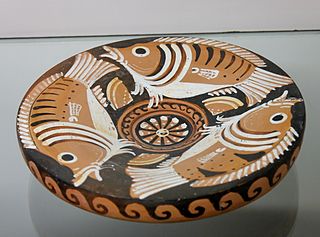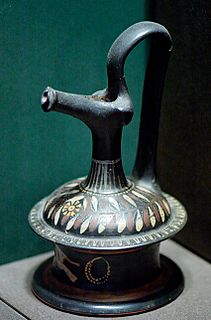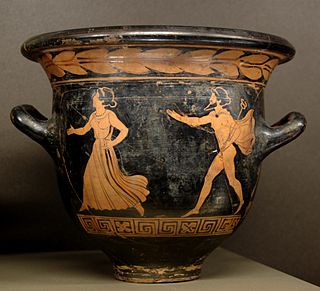Overview
The interchange of iconography, techniques, and ideas between the major pottery centers of the Hellenistic Period was formidable. One can see the influences of Corinth, Athens, Etruria, and cross pollination throughout the fabrics of Magna Graecia. There are five regions which produced South Italian ware: Apulia, Lucania, Paestum, Campania, and Sicily. These regions, in turn, had various workshops within them.
Later centers also developed in Teano (Campania), Canosa (Apulia), and Gnathia (Apulia), but these potteries are moving away from Classical red figure towards the less figurative work of the later Hellenistic and Graeco-Roman Periods.
All South Italian fabrics were originally scions from the Attic workshops of Athens, when artists began to leave that city following the Peloponnesian Wars. The earliest workshops seem to have been founded in Lucania, and Apulia. Others were founded in Sicily, and then scions from the Sicilian workshops established those in Paestum and Campania.
South Italian ware illustrates many ancient Greek dramas and myths which are unknown in Mainland Greek pottery fabrics like those of Athens (Attic ware), Sparta (Laconian ware), and Corinth (Corinthian ware).
Almost all of the pottery forms developed in Greece were also produced in South Italy. However, South Italian potters developed some of these traditional forms in new directions. For instance, Apulian potters take the volute krater and loutrophoros to new heights of fancy, making them far more elaborate than their Athenian forerunners. Apulian potters, having a taste for the frilly and elaborate, take traditional forms such as the Panathenaic amphora, the oinochoe, the lekythos, attenuate their forms, exaggerate their flares, add volute handles, molded gorgoneia, affectionately dubbed "macaroons", and end up with extremely elegant new varieties of pottery which still fit within the Hellenistic aesthetic, and end up becoming standard in the subsequent Graeco-Roman world.
New Italiote forms come about through experimentation and borrowing from local Italic cultures. In Campania, the bail amphora was invented. This is an amphora shape which has a single handle across the mouth rather than the usual double handles on the neck or shoulder. Local Italic forms made by native peoples were also borrowed into the South Italian repertoire. The Messapian trozzella is borrowed and becomes the nestoris, an elaborate form having a large belly, a pair of lug handles, a pair of neck to shoulder handles, and molded rosettes.
Some elements of decoration were also innovative. Apulian artists use polychromatic, coiling tendrils and flower forms including roses, poppies, and whirling swirls to fill necks and other traditionally black areas of vases. Frequent use is made of portrait or cameo faces of nymphs and satyrs. Rosettes, vine leaves, and other fillers get more and more elaborate. Italiote artists also created a technique called "sovradipinto," in which multiple layers of colored slips were used to add chiaroscuro (highlight and lowlight) for figures and decorations. The Campanian artists seem to have favored the use of a broader palette of colors than the other fabrics, often making female figures with white skin, while leaving male figures in red, and then adding many purple red, yellow, and white details all over the vases. Italiote artists were also extremely adept at using the false red figure technique, also known as Six's technique. This is the application of red and white slips on top of the black gloss rather than leaving figures and designs in reserve, as was the usual Athenian custom. This technique was also very popular in Etruria and may hail from that region.

Ancient Greek pottery, due to its relative durability, comprises a large part of the archaeological record of ancient Greece, and since there is so much of it, it has exerted a disproportionately large influence on our understanding of Greek society. The shards of pots discarded or buried in the 1st millennium BC are still the best guide available to understand the customary life and mind of the ancient Greeks. There were several vessels produced locally for everyday and kitchen use, yet finer pottery from regions such as Attica was imported by other civilizations throughout the Mediterranean, such as the Etruscans in Italy. There were a multitude of specific regional varieties, such as the South Italian ancient Greek pottery.

Black-figure pottery painting, also known as the black-figure style or black-figure ceramic, is one of the styles of painting on antique Greek vases. It was especially common between the 7th and 5th centuries BCE, although there are specimens dating as late as the 2nd century BCE. Stylistically it can be distinguished from the preceding orientalizing period and the subsequent red-figure pottery style.

Red-figure vase painting is one of the most important styles of figural Greek vase painting.

A fish plate is a Greek pottery vessel used by western, Hellenistic Greeks during the fourth century BC. Although invented in fifth-century BC Athens, most of the corpus of surviving painted fish plates originate in Southern Italy, where fourth-century BC Greek settlers, called "Italiotes," manufactured them.

Nikosthenes was a potter of Greek black- and red-figure pottery in the time window 550–510 BC. He signed as the potter on over 120 black-figure vases, but only nine red-figure. Most of his vases were painted by someone else, called Painter N. Beazley considers the painting "slovenly and dissolute;" that is, not of high quality. In addition, he is thought to have worked with the painters Anakles, Oltos, Lydos and Epiktetos. Six's technique is believed to have been invented in Nikosthenes' workshop, possibly by Nikosthenes himself, around 530 BC. He is considered transitional between black-figure and red-figure pottery.

Hellenistic art is the art of the Hellenistic period generally taken to begin with the death of Alexander the Great in 323 BC and end with the conquest of the Greek world by the Romans, a process well underway by 146 BCE, when the Greek mainland was taken, and essentially ending in 30 BCE with the conquest of Ptolemaic Egypt following the Battle of Actium. A number of the best-known works of Greek sculpture belong to this period, including Laocoön and His Sons, Venus de Milo, and the Winged Victory of Samothrace. It follows the period of Classical Greek art, while the succeeding Greco-Roman art was very largely a continuation of Hellenistic trends.
Geometric art is a phase of Greek art, characterized largely by geometric motifs in vase painting, that flourished towards the end of the Greek Dark Ages, c. 900–700 BC. Its center was in Athens, and from there the style spread among the trading cities of the Aegean. The Greek Dark Ages lasted from c. 1100 to 750 BC and include two periods, the Protogeometric period and the Geometric period, in reference to the characteristic pottery style. The vases had various uses or purposes within Greek society, including, but not limited to, funerary vases and symposium vases.

Arthur Dale Trendall, was a New Zealand art historian and classical archaeologist whose work on identifying the work of individual artists on Greek ceramic vessels at Apulia and other sites earned him international prizes and a papal knighthood.

Asteas was one of the more active ancient Greek vase painters in Magna Graecia, practicing the red-figure style. He managed a large workshop, in which above all hydriai and kraters were painted. He painted mostly mythological and theatrical scenes. He is one of the few vase painters of the Greek colonies whose name comes down to us.

Bucchero is a class of ceramics produced in central Italy by the region's pre-Roman Etruscan population. This Italian word is derived from the Latin poculum, a drinking-vessel, perhaps through the Spanish búcaro, or the Portuguese púcaro.

The Ilioupersis Painter was an Apulian vase painter. His works are dated to the second quarter of the 4th century BC.

The Darius Painter was an Apulian vase painter and the most eminent representative at the end of the "Ornate Style" in South Italian red-figure vase painting. His works were produced between 340 and 320 BC.

Apulian vase painting was a regional style of South Italian vase painting from ancient Apulia. It comprises geometric pottery and red-figure pottery.

Sicilian vase painting was a regional style of South Italian red-figure vase painting. It was one of five South Italian regional styles. The vase painting of Sicily was especially closely connected with the Lucanian and Paestan styles.

Gnathia vases are a type of pottery belonging to ancient Apulian vase painting of the 4th century BC.

Campanian vase painting is one of the five regional styles of South Italian red-figure vase painting. It forms a close stylistic community with Apulian vase painting.

Lucanian vase painting was substyle of South Italian red-figure vase painting, produced in Lucania between 450 and 325 BC. It was the oldest South Italian regional style. Together with Sicilian and Paestan vase painting, it formed a close stylistic community.

Paestan vase painting was a style of vase painting associated with Paestum, a Campanian city in Italy founded by Greek colonists. Paestan vase painting is one of five regional styles of South Italian red-figure vase painting.

The Painter of the Berlin Dancing Girl was an Apulian red-figure vase painter, who was active between 430–410 BC. He was named after a calyx krater in the collection of the Antikensammlung Berlin, which depicts a girl dancing to the aulos played by a seated woman.

Ancient Greek art stands out among that of other ancient cultures for its development of naturalistic but idealized depictions of the human body, in which largely nude male figures were generally the focus of innovation. The rate of stylistic development between about 750 and 300 BC was remarkable by ancient standards, and in surviving works is best seen in sculpture. There were important innovations in painting, which have to be essentially reconstructed due to the lack of original survivals of quality, other than the distinct field of painted pottery.























